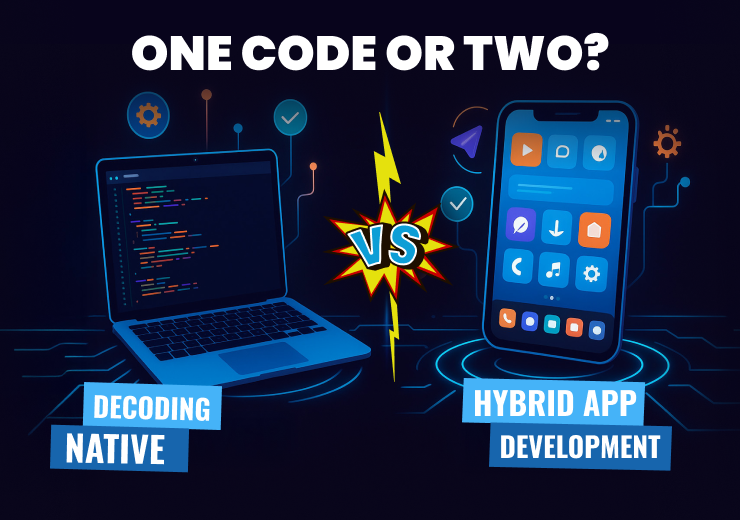- admin
- May 26th, 2025
- 5 min Read
One Code or Two? Decoding Native vs. Hybrid App Development
In the digital-first world, mobile apps are no longer just an extension of your website—they’re often the front door to your brand. Whether you’re building a product for customers or streamlining your internal processes, choosing the right app development strategy is crucial. The big question that arises is: Native or Hybrid—what’s the best path for your project?
Let’s unpack the differences between native and hybrid app development, analyze the pros and cons, and help you make an informed decision that aligns with your business goals, timelines, and budgets.
What Is Native App Development?
Native apps are built specifically for a particular mobile operating system—typically Android or iOS. Developers use platform-specific languages and tools like Swift or Objective-C for iOS, and Java or Kotlin for Android.
These apps are installed directly onto a user’s device and can access system resources like camera, GPS, or push notifications with optimal speed and responsiveness.
Pros of Native Apps:
- Performance: Native apps are faster and more efficient because they are optimized for a specific platform.
- User Experience (UX): Offers the best UI/UX as it adheres to platform-specific guidelines.
- Access to Hardware Features: Seamless integration with device features like camera, GPS, and Bluetooth.
- Scalability: Easier to scale and maintain performance with increasing users.
Cons of Native Apps:
- Cost: Requires separate development for each platform, increasing development time and costs.
- Time-Intensive: Maintaining two separate codebases doubles the workload.
- Talent Requirement: Developers must specialize in platform-specific languages and tools.
What Is Hybrid App Development?
Hybrid apps are built using web technologies like HTML, CSS, and JavaScript, and are wrapped in a native container using frameworks like Ionic, React Native, or Flutter. This enables them to run on both Android and iOS from a single codebase.
While the core is built as a web app, the shell allows it to behave like a native app on mobile devices.
Pros of Hybrid Apps:
- Cost-Effective: One codebase works for both iOS and Android, reducing development and maintenance costs.
- Faster Time to Market: Shared codebase speeds up development and updates.
- Wider Reach: Reach users across platforms with a single app.
- Simplified Maintenance: Bug fixes and feature updates can be rolled out across both platforms simultaneously.
Cons of Hybrid Apps:
- Performance Limitations: May lag behind native apps in terms of performance, especially for high-load or graphics-heavy applications.
- Limited Access to Native Features: Some device functionalities may be harder to access or require plugins.
- Inconsistent UX: Might not fully adhere to design norms of each platform, leading to a less polished user experience.
Native vs. Hybrid: Which One Should You Choose?
The decision ultimately depends on several critical factors:
1. Project Complexity
- For complex, high-performance applications like gaming or real-time financial apps, native is the clear winner.
- For content-driven or MVP applications, hybrid apps offer a quicker and more affordable solution.
2. Time to Market
- Native apps typically require more time due to dual development.
- Hybrid apps let you launch faster, which is ideal for startups or businesses testing market response.
3. Budget Constraints
- If budget is tight, hybrid apps are cost-effective and ideal for reaching both Android and iOS audiences simultaneously.
- For businesses with a larger budget looking for the best performance and UX, native is a solid investment.
4. Long-Term Vision
- If your app will grow in complexity or scale significantly, starting with a native approach might save time and resources later.
- Hybrid apps are excellent for short-term needs, prototypes, or apps with moderate functionality.



